-
 Bitcoin
Bitcoin $114400
1.32% -
 Ethereum
Ethereum $3499
2.20% -
 XRP
XRP $2.922
4.26% -
 Tether USDt
Tether USDt $0.0000
0.03% -
 BNB
BNB $752.6
1.53% -
 Solana
Solana $161.8
1.64% -
 USDC
USDC $0.9999
0.01% -
 TRON
TRON $0.3267
1.32% -
 Dogecoin
Dogecoin $0.1991
3.02% -
 Cardano
Cardano $0.7251
3.29% -
 Hyperliquid
Hyperliquid $38.32
3.36% -
 Stellar
Stellar $0.3972
7.58% -
 Sui
Sui $3.437
2.74% -
 Chainlink
Chainlink $16.29
3.65% -
 Bitcoin Cash
Bitcoin Cash $545.3
3.70% -
 Hedera
Hedera $0.2482
7.49% -
 Ethena USDe
Ethena USDe $1.001
0.03% -
 Avalanche
Avalanche $21.40
2.02% -
 Toncoin
Toncoin $3.579
1.56% -
 Litecoin
Litecoin $109.3
2.20% -
 UNUS SED LEO
UNUS SED LEO $8.951
-0.18% -
 Shiba Inu
Shiba Inu $0.00001220
2.75% -
 Polkadot
Polkadot $3.613
2.99% -
 Uniswap
Uniswap $9.173
3.78% -
 Monero
Monero $302.6
2.62% -
 Dai
Dai $0.0000
0.00% -
 Bitget Token
Bitget Token $4.320
1.52% -
 Pepe
Pepe $0.00001048
3.40% -
 Cronos
Cronos $0.1314
4.33% -
 Aave
Aave $259.4
3.54%
What is the historical development of Bitcoin ETFs?
Bitcoin ETF approval's long journey reflects regulatory hesitancy, initially due to market manipulation fears and Bitcoin's volatility, but recent approvals signal growing institutional acceptance and evolving regulatory frameworks.
Feb 27, 2025 at 10:42 am
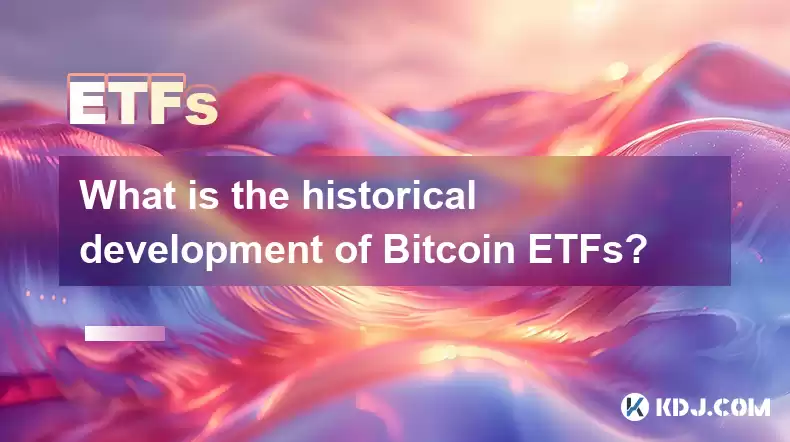
What is the Historical Development of Bitcoin ETFs?
Key Points:
- The long and winding road to Bitcoin ETF approval reflects regulatory uncertainty and evolving market sentiment.
- Early attempts faced significant hurdles due to concerns about market manipulation, investor protection, and the inherent volatility of Bitcoin.
- Gradual shifts in regulatory perspectives, coupled with increasing institutional interest and Bitcoin's maturation as an asset class, have paved the way for recent approvals.
- The approval process has varied significantly across different jurisdictions, highlighting the fragmented nature of global cryptocurrency regulation.
- Future developments will likely focus on expanding the range of Bitcoin ETF products and addressing evolving regulatory challenges.
The journey towards Bitcoin Exchange-Traded Funds (ETFs) has been a protracted and complex one, marked by both setbacks and incremental progress. Understanding its historical development requires examining the interplay of regulatory frameworks, market dynamics, and technological advancements. This article delves into the key stages of this evolution, exploring the challenges faced and the breakthroughs achieved.
- The Early Days and Regulatory Uncertainty (Pre-2017): The very concept of a Bitcoin ETF was initially met with skepticism and resistance from regulatory bodies. The nascent cryptocurrency market lacked the established infrastructure and oversight considered necessary for a mainstream financial product. Concerns centered around the potential for market manipulation due to Bitcoin's decentralized nature and relatively thin trading volumes. Furthermore, regulators grappled with the novelty of cryptocurrencies and their implications for investor protection. The lack of a clear regulatory framework created significant uncertainty for potential ETF issuers, hindering any serious attempts at launching such a product. Many considered Bitcoin to be too volatile and speculative for inclusion in a regulated exchange-traded vehicle. The decentralized and pseudonymous nature of Bitcoin also presented challenges in verifying ownership and preventing fraudulent activity, which were key concerns for regulators. This early period was characterized by a significant knowledge gap on the part of regulators, leading to a cautious and often hesitant approach to Bitcoin and other cryptocurrencies. The lack of established precedent and the fear of setting a precedent for other potentially risky assets contributed to the delay in approving Bitcoin ETFs. This hesitancy wasn't solely driven by concerns about fraud or manipulation; it also stemmed from a lack of understanding of the underlying technology and the broader implications of integrating cryptocurrencies into the traditional financial system. The initial absence of robust custodial solutions for Bitcoin also posed a challenge, as securing the assets underlying the ETF was crucial for investor protection. Without clear guidance from regulatory bodies, issuers were reluctant to proceed with ETF applications, fearing rejection or facing significant legal hurdles.
- The First Wave of Applications and Rejections (2017-2019): As Bitcoin's market capitalization grew and its profile increased, the first wave of Bitcoin ETF applications began to emerge. However, these early attempts largely met with rejection from the Securities and Exchange Commission (SEC) in the United States. The SEC cited concerns about market manipulation, the lack of sufficient safeguards against fraud, and the overall volatility of the Bitcoin market. The rejections highlighted the significant hurdles that ETF issuers would need to overcome to gain approval. Specific concerns included the lack of robust surveillance-sharing agreements between exchanges and the potential for wash trading and other manipulative practices to inflate the price of Bitcoin. The SEC emphasized the need for a regulated market structure to ensure fair pricing and protect investors. The rejections were not solely based on concerns about Bitcoin itself, but also reflected a broader regulatory hesitancy towards cryptocurrencies and the lack of a comprehensive framework for their oversight. Many applications were rejected due to insufficient evidence of robust anti-money laundering (AML) and know-your-customer (KYC) measures. The lack of established precedent and the fear of setting a precedent for other potentially risky assets also played a role in the SEC's decisions. These rejections, while discouraging, spurred further efforts by ETF issuers to address the SEC's concerns. They focused on developing more robust surveillance mechanisms, strengthening their partnerships with regulated exchanges, and providing more compelling evidence of market integrity.
- The Rise of Institutional Interest and Regulatory Evolution (2020-2022): A significant shift occurred during this period, driven by increased institutional adoption of Bitcoin. Large financial institutions, hedge funds, and asset managers began to allocate a portion of their portfolios to Bitcoin, demonstrating a growing acceptance of the cryptocurrency as an asset class. This growing institutional interest exerted pressure on regulators to reconsider their approach to Bitcoin ETFs. The increased trading volume and liquidity in regulated Bitcoin futures markets also provided a stronger foundation for the development of Bitcoin ETFs. These futures markets offered a degree of regulatory oversight and transparency that was absent in the earlier, more fragmented spot markets. The SEC began to signal a potential shift in its stance, indicating that it might be more open to approving Bitcoin ETFs if certain conditions were met. This change in perspective reflected a growing understanding of Bitcoin's evolution and the increasing sophistication of the cryptocurrency market. Regulatory agencies began to develop more comprehensive frameworks for the oversight of cryptocurrencies, which facilitated the creation of a more stable and secure environment for Bitcoin ETFs. The increasing focus on investor protection and the establishment of clear guidelines for market surveillance contributed to a more receptive regulatory climate. The growing maturity of the cryptocurrency market, combined with improved regulatory clarity, laid the groundwork for the eventual approval of Bitcoin ETFs. This period also saw increased discussion about the potential benefits of Bitcoin ETFs, such as increased accessibility for retail investors and improved price discovery.
- The First Approvals and Beyond (2023-Present): After years of delays and rejections, the first Bitcoin ETFs were finally approved in certain jurisdictions. These approvals marked a significant milestone in the development of the cryptocurrency market and demonstrated a growing acceptance of Bitcoin as a legitimate asset class. The approvals signaled a shift in regulatory sentiment and reflected the maturing of the cryptocurrency market. The approvals, however, were not without their conditions. Regulators continued to emphasize the importance of investor protection and market surveillance. The approved ETFs were subject to specific requirements designed to mitigate risks associated with Bitcoin's volatility and the potential for market manipulation. The ongoing regulatory scrutiny highlighted the need for ongoing monitoring and adaptation of the regulatory framework as the cryptocurrency market continues to evolve. The approval of Bitcoin ETFs is not a final destination but rather a step in an ongoing process. The future development of Bitcoin ETFs will likely involve the introduction of new products, the refinement of existing regulatory frameworks, and the ongoing adaptation to the ever-changing landscape of the cryptocurrency market.
- Jurisdictional Variations: The development and approval of Bitcoin ETFs have not been uniform across different jurisdictions. Some countries have been more proactive in establishing regulatory frameworks for cryptocurrencies, leading to faster approvals, while others have remained more cautious and hesitant. This reflects the fragmented nature of global cryptocurrency regulation and the different approaches taken by various regulatory bodies. The differences in regulatory frameworks highlight the complexity of navigating the global cryptocurrency landscape and the challenges faced by ETF issuers seeking to launch products in multiple jurisdictions. The varying levels of regulatory maturity and the different priorities of regulatory bodies contribute to the diverse landscape of Bitcoin ETF availability worldwide. The ongoing evolution of regulatory frameworks in different jurisdictions will continue to shape the future of Bitcoin ETFs and their global accessibility. Understanding these jurisdictional differences is crucial for both issuers and investors navigating the complex world of Bitcoin ETFs.
FAQs:
Q: What are the major concerns that regulators have regarding Bitcoin ETFs?
A: Regulators have historically expressed concerns about market manipulation, the lack of sufficient safeguards against fraud, the volatility of Bitcoin's price, and the potential for money laundering. These concerns stem from the decentralized nature of Bitcoin and the relatively young age of the cryptocurrency market. Addressing these concerns has been a key focus for ETF issuers seeking regulatory approval.
Q: What role did institutional investment play in the eventual approval of Bitcoin ETFs?
A: The increasing adoption of Bitcoin by large institutional investors demonstrated growing confidence in the asset class and exerted significant pressure on regulators to reconsider their stance. This institutional interest added legitimacy and maturity to the Bitcoin market, making it more appealing for ETF approval.
Q: What are the key differences between Bitcoin ETFs and other investment vehicles like Bitcoin futures contracts?
A: Bitcoin ETFs offer investors exposure to Bitcoin through a regulated exchange-traded product, providing greater accessibility and potentially lower transaction costs than directly investing in Bitcoin. Bitcoin futures contracts, on the other hand, are agreements to buy or sell Bitcoin at a future date, offering a different type of exposure and risk profile.
Q: What is the future outlook for Bitcoin ETFs?
A: The future likely involves an expansion of Bitcoin ETF products, potentially including different types of ETFs (e.g., actively managed, leveraged, or inverse ETFs), as well as greater regulatory clarity and harmonization across different jurisdictions. The continued evolution of the cryptocurrency market will shape the future landscape of Bitcoin ETFs.
Disclaimer:info@kdj.com
The information provided is not trading advice. kdj.com does not assume any responsibility for any investments made based on the information provided in this article. Cryptocurrencies are highly volatile and it is highly recommended that you invest with caution after thorough research!
If you believe that the content used on this website infringes your copyright, please contact us immediately (info@kdj.com) and we will delete it promptly.
- Kaspa, HBAR, and Cold Wallet: A New York Minute on Crypto's Latest Moves
- 2025-08-04 09:11:54
- Ethereum Whale Watch: Selling Pressure and Price Volatility
- 2025-08-04 09:11:54
- XRP ETF Mania: Teucrium's Crypto Triumph and the Altcoin Frenzy
- 2025-08-04 09:30:13
- Crypto Wallet Scam: A $900K Loss & What You Need to Know
- 2025-08-04 09:35:13
- Dogecoin's Wild Ride: Elliott Wave, Stochastic RSI, and What's Next, Ya Know?
- 2025-08-04 09:40:12
- Shiba Inu (SHIB), Crypto Investments, and the Meme Coin Evolution: What's the Deal?
- 2025-08-04 09:45:17
Related knowledge
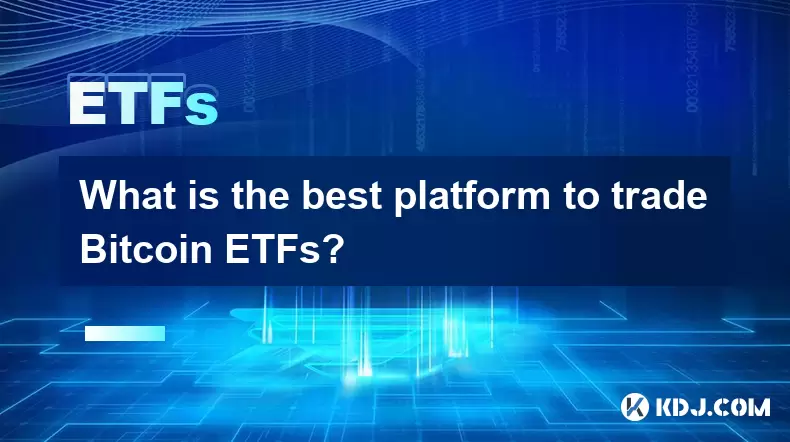
What is the best platform to trade Bitcoin ETFs?
Jul 23,2025 at 04:14am
Understanding Bitcoin ETFs and Their Role in TradingBitcoin Exchange-Traded Funds (ETFs) have gained significant traction among traditional and crypto...
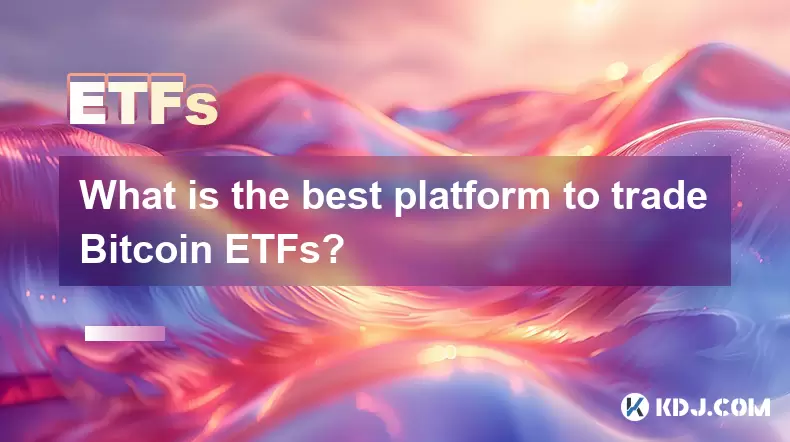
What is the best platform to trade Bitcoin ETFs?
Jul 17,2025 at 03:50pm
Understanding Bitcoin ETFs and Their Role in the MarketBitcoin Exchange-Traded Funds (ETFs) are investment vehicles that track the price of Bitcoin wi...

Will a Bitcoin ETF be available in my 401(k)?
Jul 17,2025 at 10:42pm
What is a Bitcoin ETF?A Bitcoin ETF (Exchange-Traded Fund) is an investment vehicle that tracks the price of Bitcoin without requiring investors to di...
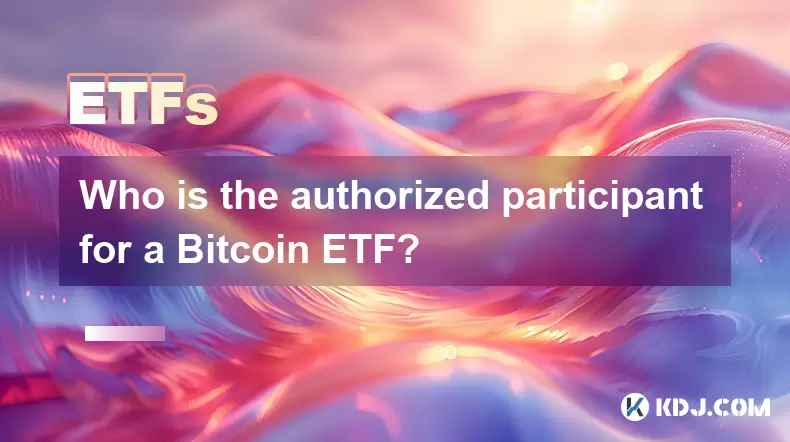
Who is the authorized participant for a Bitcoin ETF?
Jul 18,2025 at 12:42am
Understanding the Role of Authorized Participants in Bitcoin ETFsIn the context of Bitcoin Exchange-Traded Funds (ETFs), an authorized participant (AP...
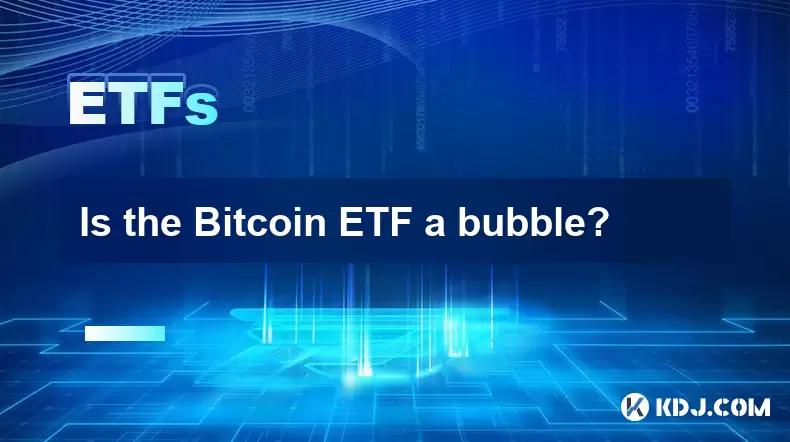
Is the Bitcoin ETF a bubble?
Jul 20,2025 at 06:57am
Understanding the Bitcoin ETF ConceptA Bitcoin Exchange-Traded Fund (ETF) is a financial product that aims to track the price of Bitcoin without requi...
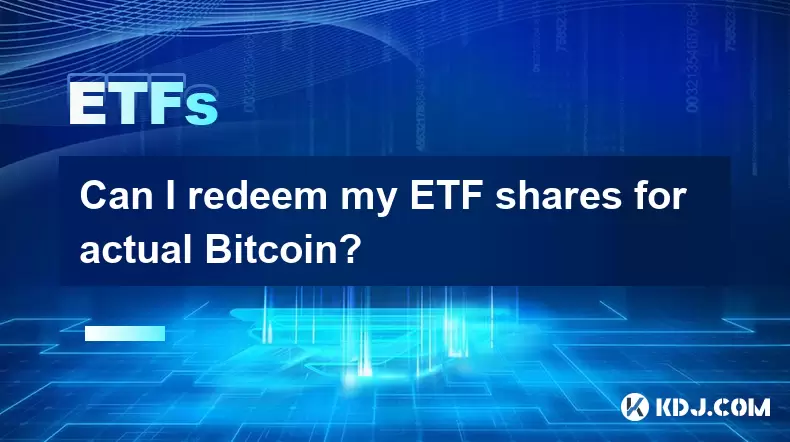
Can I redeem my ETF shares for actual Bitcoin?
Jul 17,2025 at 03:14pm
Understanding ETF Shares and Their Relation to BitcoinExchange-Traded Funds (ETFs) have become a popular investment vehicle for those looking to gain ...

What is the best platform to trade Bitcoin ETFs?
Jul 23,2025 at 04:14am
Understanding Bitcoin ETFs and Their Role in TradingBitcoin Exchange-Traded Funds (ETFs) have gained significant traction among traditional and crypto...

What is the best platform to trade Bitcoin ETFs?
Jul 17,2025 at 03:50pm
Understanding Bitcoin ETFs and Their Role in the MarketBitcoin Exchange-Traded Funds (ETFs) are investment vehicles that track the price of Bitcoin wi...

Will a Bitcoin ETF be available in my 401(k)?
Jul 17,2025 at 10:42pm
What is a Bitcoin ETF?A Bitcoin ETF (Exchange-Traded Fund) is an investment vehicle that tracks the price of Bitcoin without requiring investors to di...

Who is the authorized participant for a Bitcoin ETF?
Jul 18,2025 at 12:42am
Understanding the Role of Authorized Participants in Bitcoin ETFsIn the context of Bitcoin Exchange-Traded Funds (ETFs), an authorized participant (AP...

Is the Bitcoin ETF a bubble?
Jul 20,2025 at 06:57am
Understanding the Bitcoin ETF ConceptA Bitcoin Exchange-Traded Fund (ETF) is a financial product that aims to track the price of Bitcoin without requi...

Can I redeem my ETF shares for actual Bitcoin?
Jul 17,2025 at 03:14pm
Understanding ETF Shares and Their Relation to BitcoinExchange-Traded Funds (ETFs) have become a popular investment vehicle for those looking to gain ...
See all articles

























































































